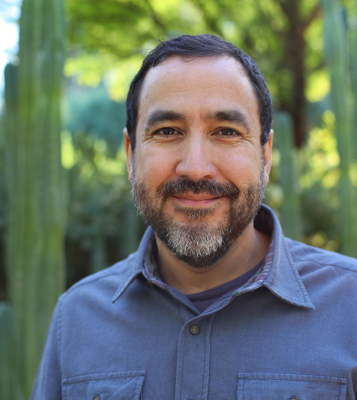Jet Fuel Series: A conversation with Robert Pérez, Founder and Chief Exploration Officer, Wonder for Good
Robert Pérez is also the guest of the workshop Telling A Heartwired Brand Story, February 25th, 2022, during which he will share more about the Heartwired Approach and work with the participants to include this technique into their mission-driven work.
When it comes to increasing your impact, curiosity and listening as a constant practice are as important as applying any other skills, strategies, and practices in your work. In fact, Robert Perez, Founder and Chief Exploration Officer at Wonder for Good, would argue that for changemakers being curious about their audiences is a necessary step to identifying new strategies or refining existing ones to advance mission-driven work.
Diving into who those different audiences are, and the strategic objectives you can meet for each of them, is at the core of Robert’s work. It’s all part of what Wonder for Good (which Robert refers to mononymously as Wonder) calls their heartwired approach to audience research and storytelling.
Activation, persuasion, and neutralization
What’s immediately notable about Wonder’s heartwired approach is how expansive it is in its definition of audiences. Most of the social impact space is built around mobilizing the population that is already passionate about a cause. These, after all, are the people most likely to already be giving their time and resources to organizations and enterprises that are aligned with their own values.
But Robert makes the point that this isn’t the only audience changemakers should be engaging with if growth and progress is the goal. In the heartwired framework, changemakers are often confronting three types of engagement — what Robert calls strategic communication objectives — simultaneously. Those are activation, persuasion, and neutralization.
Changemakers are probably most versed and already quite successful at activating their core audience. “These are your people who are already with you. They already believe in your vision of the world,” says Robert. “There’s no gray space. They don’t need to be persuaded.”
Communication with these core audiences — the ones that you’re trying to activate — can take the form of a reminder to donate or a call to action. In a sense, this is the audience that trusts you to tell them what they can do to make an impact on something you’re both passionate about. It’s a marked difference from the tactics to use with folks who are unaware of, conflicted about, or outright adversarial towards your issue. But the heartwired approach accounts for even those audiences.
Persuasion is often the aim with what’s potentially your largest audience — the one that is, as Robert puts it, not necessarily opposed to you, but not necessarily with you either.
“They’re having that internal dialogue and they need the moral nudge — the heartwired nudge — to move them in the right direction,” says Robert. “That’s where a particularly effective heartwired story can come in handy to help them think about why they should care or think differently about an issue.”
“(…) they need the heartwired nudge to move them into the right direction. That’s where a particular effective heartwired story can come in-handy to help them think about why they should care or think differently about an issue (…)”
Robert Pérez, Founder and Chief Exploration Officer, Wonder for Good
For an audience that’s actively adversarial, the goal is neutralization. Dedicated outreach to people who are fundamentally opposed to what you’re trying to accomplish may seem counterintuitive, if not a total waste of time. But just because your opposition may never come around as donors, volunteers, or stakeholders doesn’t mean it’s an audience to neglect entirely.
“If they’re so hyper-charged in their opposition to you and your mission, they could make life really difficult for you,” says Robert.
“So neutralization is just [about] lowering the temperature, so that they eventually say, ‘You know what? I don’t necessarily like those folks, but I’ve got more important things to do. So I’m just going to ignore them and get on with my life.’”
Robert and his colleagues at Wonder find that most often, changemakers are activating, persuading, and neutralizing different audiences at the same time. And in many cases, more than one of these objectives is necessary within audiences and communities — a point that highlights one hallmark of the heartwired approach: nuance.
The nuance is significant. It’s tempting and all too easy to paint things in broad brush strokes, or in rigid black and white terms. But what Robert has observed in his career — first as an activist, then as a strategic communicator, and now as a consultant focused on audience research — is that people are almost always on a spectrum when it comes to social issues.
The heartwired approach
In stark contrast to the polarities that can dominate the discourse, Robert says “the reality is that there are lots of shades of gray.” That is, people are usually on a spectrum with social issues rather than a side. Wonder’s heartwired approach is all about helping changemakers understand where those shades of gray come from, rather than trying to slot a person based on them.
The heartwired framework identifies five factors that shape people’s attitudes and behaviors: emotions, identity, lived experiences, values, and beliefs. In instances where all five are in alignment, Robert explains, that is usually where an individual feels unambiguously one way or the other about a cause. Most often, however, the factors aren’t necessarily in perfect alignment and there’s internal friction.
“What we have come to learn at Wonder is that not all stories are created equally. What we try to do is to understand the heartwire power of a story and that is our approach to communication. Our brains are hardwired. At Wonder, we have come to learn that human beings are heartwired.”
Robert Pérez, Founder and Chief Exploration Officer, Wonder for Good
Storytelling, it turns out, can be a singular source of clarity in the midst of that internal friction. Much of Robert’s longtime collaboration with public opinion researcher and Heartwired coauthor Amy Simon has been about understanding why storytelling — on the neurological and psychological level — is so transformative.
Not only are people’s attitudes and behaviors predicated on storytelling, but the investment and emotional synchronicity people experience when they’re invested in another person’s story can fundamentally change their perception.
“When you are engrossed in a story — whether that’s something you are reading, hearing, or Netflix-bingeing over the course of a weekend — your emotions are synchronized with [a character’s] emotions,” says Robert.
“If you really feel a sense of kinship or shared identity with the character whose life is playing out in a book or on a screen, you’re feeling their experiences and you’re seeing the world through their eyes.”
The heartwired approach to social impact storytelling is a way of reverse-engineering that empathy — first by seeing the world through your different audiences’ eyes, then framing your issues in terms that are heartwired for them. At the foundation of this approach is curiosity. Robert makes the point that even though there’s not a price tag associated with curiosity, and technically anybody can make a conscious effort to practice it, curiosity as an exercise is not simple or undemanding.
“Sometimes you have to be curious about people who you feel are against you. You have to be curious about people who are saying things that are transphobic or racist, or people who express opinions that are anti-Muslim or anti-immigrant,” says Robert. “And why would I want to be curious about people like that?”
Robert makes two points about navigating that question. First, he stresses that we can’t forget that people have the ability to change. “Who we are today is not who we are, always. Who we are today is not who we can be tomorrow. We have the ability to change as human beings,” says Robert.
“In a way that’s pretty amazing, we have the ability to be good to complete strangers, as long as we’re able to see our shared humanity. And the thing that facilitates cruelty and hate and racism is an inability to see how we are connected — how we are one.”
However, as a second point, Robert does stress that trauma is a very real consideration when individual changemakers are determining which audiences they have the emotional bandwidth to be curious about.
“I just want to name that if you experience trauma in the form of misogyny, racism, transphobia, ableism, it is completely understandable to say, ‘Y’all, I’m out. I don’t want my job to have to be bringing people along,’” says Robert. “That is a very normal, human posture when you have experienced deep trauma because of the way hate manifests in the world. We have to figure out where we can show up.”
Where to begin
Most changemakers won’t have a dedicated budget for something that sounds as luxurious and lofty as audience research. But Robert insists that you don’t really need one to start naturalizing the heartwired approach in your own work. That’s not by accident.
“We start our work from a place of curiosity about the audience we need to persuade which is not easy to do. Sometimes you have to be curious about people who you feel are against you (…).”
Robert Pérez, Founder and Chief Exploration Officer, Wonder for Good
“One of the reasons that I started Wonder is that I wanted to make audience research accessible to changemakers — to the range of changemakers — so that it didn’t require a huge budget.”
Downloading Robert and Amy Simon’s Heartwired is certainly a free place to start for a deep dive into heartwired storytelling. Another free place to start is building curiosity into every engagement with your stakeholders.
Robert cites several approaches that his clients have had success with, including short, casual interviews at bus stops, email subject line A/B testing, and — particularly with meetings in the pandemic era — Zoom polls.
In each engagement with their stakeholders, one organization Wonder worked with began Zoom sessions with a poll to determine which message resonated most with that audience. “They did it three times and they discovered, ‘We shouldn’t be saying social capital, we should be saying a web of supportive relationships,’” says Robert. “All they did was a Zoom poll three times and they got conclusive evidence.”
Building audience research into existing engagements is an effective (and generally free!) way to learn more about your different audiences. And it can all feed directly into accelerating change on your issue.
“What are your change goals? What are you trying to accomplish? Whose minds do you need to activate, persuade, and neutralize to get there?” Robert asks, summing up the endgame of the heartwired approach. “And then what will it take to learn enough about those audiences to be able to make genuine progress?”
The “enough” in Robert’s question is significant because the work of curiosity — much like the incremental progress that characterizes most social change work — is about getting deeper and further along, not necessarily reaching the generational, watershed milestones.
“Progress looks like getting people to move one step at a time toward the better angels of our nature,” says Robert. “If you think about the change that has happened in your own mind around issues, we’re not, as human beings, people who tend to move in extremes from one day to another. We usually move in a very concerted, incremental way. But we do have the capacity to move.”
A heartwired approach to learning about your audiences — listening for what resonates for them and understanding the context of their attitudes and behaviors, whether they’re apathetic or adversarial — is a way of appealing to people’s natural capacity to move. All progressive social change hinges on precisely that, and changemakers have curiosity and storytelling to help accelerate it.

Robert Pérez is the founder and chief exploration officer at Wonder: Strategies for Good. The son of migrant farmworkers, Robert was brought up in Indio, California, and has dedicated the last 30 years of his life to working with people and organizations to achieve change within their walls and out in the world.
With support from the David and Lucile Packard Foundation, Robert and his long-time collaborator, Amy Simon, are co-authors of Heartwired: Human Behavior, Strategic Opinion Research and the Audacious Pursuit of Social Change, a strategy guide for change-makers. In Heartwired, Robert and Amy chronicle how the Heartwired approach to audience research and strategy has supported historic wins — from the freedom to marry for same-sex couples to making medical aid-in-dying a legal option for terminally ill people.
Previously, Robert was a senior vice president at Fenton Communications. When’s he’s not developing Heartwired strategies, Robert can be found out on an urban hike in San Francisco with his husband, Robert. Yep, two Roberts!
The Jet Fuel Series aims to bring different perspectives to the debate that currently dominates the mission-driven sector, addressing the needs of nonprofit or for profit entities alike. Caravanserai Project will publish a monthly blog based on conversations we had with various stakeholders such as futurists, community leaders, academics, entrepreneurs, captains of various industries, from different walks of life and locations whose unique experiences and views hopefully will help us and our network reimagine our efforts in order to increase our impact and advance our missions.

This blog was made possible in part by the generous support provided by the Wells Fargo Open for Business Fund. Caravanserai Project is the recipient of a Wells Fargo Open for Business Fund award aiming to provide programs and services that support small business viability through growth, expansion, innovation, and increased productivity. Read more about this award.






